
The papaya, papaw, or pawpaw is the plant Carica papaya, one of the 22 accepted species in the genus Carica of the family Caricaceae. Its origin is in the tropics of the Americas, perhaps from Central America and southern Mexico.

Conium is one of more than 400 genera of flowering plants in the carrot family Apiaceae. As of December 2020, Plants of the World Online accepts six species.
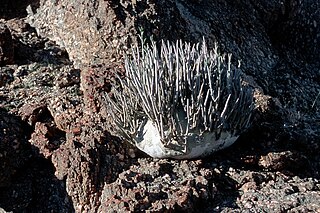
Adenia is a genus of flowering plants in the passionflower family, Passifloraceae. It is distributed in the Old World tropics and subtropics. The centers of diversity are in Madagascar, eastern and western tropical Africa, and Southeast Asia. The genus name Adenia comes from "aden", reported as the Arabic name for the plant by Peter Forsskål, the author of the genus.

Chamaerops is a genus of flowering plants in the family Arecaceae. The only currently fully accepted species is Chamaerops humilis, variously called European fan palm or the Mediterranean dwarf palm. It is one of the most cold-hardy palms and is used in landscaping in temperate climates.

Kigelia is a genus of flowering plants in the family Bignoniaceae. The genus consists of only one species, Kigelia africana, which occurs throughout tropical Africa. The so-called sausage tree grows a fruit that is up to 60 cm long, weighs about 7 kg, and resembles a sausage in a casing.

Justicia adhatoda, commonly known in English as Malabar nut, adulsa, adhatoda, vasa, vasaka,, , (Tamil:ஆடாதொடை), (Gujarati:અરડૂસી), (Hindi:अडूसा),, is a medicinal plant native to Asia, widely used in Siddha Medicine, Ayurvedic, homeopathy and Unani systems of medicine.
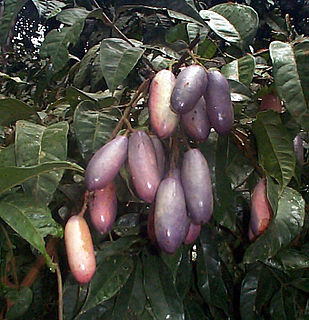
Dacryodes edulis is a fruit tree native to Africa, sometimes called safou (Cameroon), atanga, ube (Nigeria), African pear, bush pear, African plum, nsafu, bush butter tree, or butterfruit.
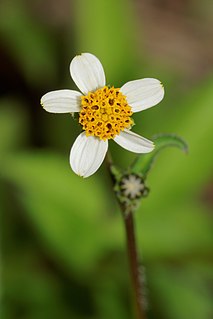
Bidens pilosa is an annual species of herbaceous flowering plant in the daisy family Asteraceae. Its many common names include black-jack, beggarticks, farmer’s friends and Spanish needle, but most commonly referred to as cobblers pegs. It is native to the Americas but is widely distributed as an introduced species in other regions worldwide including Eurasia, Africa, Australia, South America and the Pacific Islands.

Protea neriifolia, also known as the narrow-leaf sugarbush, oleander-leaved sugarbush, blue sugarbush, or the oleanderleaf protea, is a flowering plant in the genus Protea, which is endemic to South Africa.

Momordica dioica, commonly known as spiny gourd or spine gourd and also known as bristly balsam pear, prickly carolaho, teasle gourd, kantola, is a species of flowering plant in the Cucurbitaceae/gourd family. It is used as a vegetable in all regions of India and some parts in South Asia. It has commercial importance and is exported and used locally. The fruits are cooked with spices, or fried and sometimes eaten with meat or fish.It is propagated by underground tubers. It has small leaves, small yellow flowers, it has small, dark green, round or oval fruits.It is dioecious, which means that it has distinct male and female individual organisms, hence its name.

Fumaria muralis, known as common ramping-fumitory or wall fumitory, is a flowering herbaceous plant in the poppy family (Papaveraceae) native to western Europe and northwestern Africa.

Brabejum is a genus of a single species of large evergreen tree, Brabejum stellatifolium in the family Proteaceae, commonly called wild almond, bitter almond or ghoeboontjie. It is restricted in the wild to South Africa's Western Cape province, where it grows in thickets along the banks of streams. The plant is of botanical interest as being Africa's only member of the large grevilleoid subfamily. It is a bushy small tree with branches widely at ground level and numerous erect vigorous stems. Leaves grow up to 6 in (15 cm) long, narrow and bluntly toothed, appear at intervals along the branches, mostly in whorls of 6. In summer, the plant bears white flowers densely crowded on spikes arising from rusty buds at the leaf axils. The fruits to 2 in (5 cm) long, magenta to reddish brown, similar to an almond, appear in autumn. The nut is too bitter to eat; however, in earlier times it was boiled, roasted, and ground to make a "coffee" drink.

Achyranthes aspera is a species of plant in the family Amaranthaceae. It is distributed throughout the tropical world. It can be found in many places growing as an introduced species and a common weed. It is an invasive species in some areas, including many Pacific Islands environments.

Solanum macrocarpon otherwise known as the African eggplant or Vietnamese eggplant is a plant of the family Solanaceae. S. macrocarpon is a tropical perennial plant that is closely related to the eggplant. S. macrocarpon originated from West Africa, but is now widely distributed in Central and East Africa. Through an introduction from West Africa, the plant also grows in the Caribbean, South America, and some parts of Southeast Asia. S. macrocarpon is widely cultivated for its use as a food, its medicinal purposes, and as an ornamental plant.

Adenia globosa is a species of flowering plant in the passionflower family, Passifloraceae. It is native to tropical Africa, where it occurs in Ethiopia, Kenya, Somalia, and Tanzania. It is known as mpaga in Swahili.
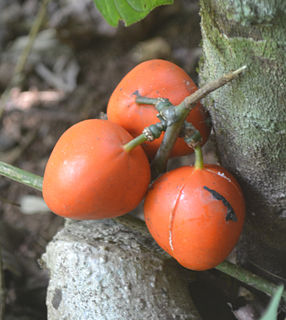
Adenia hondala, commonly known as hondala is a large, tuberous, woody climber which scrambles over other plants. It is found in the Indian subcontinent, including Sri Lanka, and in southeastern Asia. The tuber and the fruit are used as herbal remedies and the plant is used as a cure for snake bites. The caterpillars of several species of butterfly feed on this plant; these include the tawny coster, the clipper, the common cruiser and the Tamil lacewing.
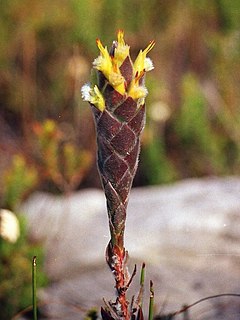
Mimetes palustris or cryptic pagoda is an evergreen shrub, assigned to the family Proteaceae. It has horizontal sprawling shoots as well as upright, unbranched shoots usually about ½ m high. The leaves are entire and stand out on the lower parts of the shoots, but are overlapping and pressed tightly against each other near the inflorescence, almost like a snakeskin. The inflorescence consists of several flowerheads, each containing three clear yellow flowers that are longer than the subtending leaves. It is the smallest species of Mimetes and is an endemic species that grows on well-drained, but permanently moist sandy and peaty slopes in the mountains near Hermanus, Western Cape province of South Africa. It is considered critically endangered. Flowering occurs all year round, but peaks in August and September.

Mimetes saxatilis or limestone pagoda is an evergreen, upright, rarely branching shrub of 1–2¼ m high, assigned to the family Proteaceae. The approximately oval leaves are 3½–5 cm (1.4–2.0 in) long and 1½–3 cm (0.6–1.2 in) wide with a blunt, thickened, reddish tip or with three crowded teeth. It has cylinder-shaped inflorescences topped by a crest of green leaves, further consisting of heads with 12-22 individual bright yellow flowers, each in the axil of a flat, green leaf. It is an endemic species that is restricted to limestone outcrops in the Agulhas plains in the very south of the Western Cape province of South Africa. It is considered an endangered species. Flowering may occur between July and December, but is unreliable in its timing, dependent on sufficient moisture availability.

Protea nana, also known as the mountain rose or mountain-rose sugarbush, is a flowering shrub which belongs within the genus Protea.


















